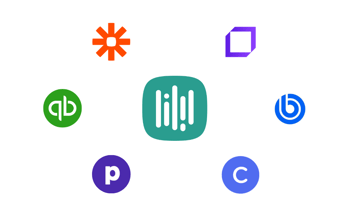5 Proven ways to increase employee working efficiency in 2022
If your employees are inefficient, the problem could be you. Learn what you can do to help your staff thrive, increase productivity, and get more done. Hint: it may not be what you think.

Vicky Frissen

Want to make 2022 the year in which both you and your employees thrive? Then it’s time to take a good hard look at the way you work.
A lot of managers have been focusing on ‘getting things done’, one way or the other. Many businesses were afraid that productivity would take a hit when employees started working from home. To combat those fears, they put ambitious KPIs and targets into place.
But in most cases, productivity didn't plummet.
In fact, countless employees found they got a lot more done when Sarah from accounting didn't come over for a quick chat every time she went to the bathroom.
On average, people who work from home spend 10 minutes less per day doing unproductive things and are 47% more productive.
Success isn't about productivity, however. It’s not just about how much you get done, but also how you do it.
As the saying goes: direction is just as important as speed—some people are going nowhere, fast.
So, pens down and stop ticking tasks off to-do lists. In this article, we’ll take a look at how to work better. These tips are not just intended to increase productivity, but to boost efficiency: to do things in the best way possible—both for your employees and your business.
1. Ask your employees what they need
Before giving your employees another quota or target, slow down and turn the conversation around: what do they need you to do better? What can you give them more of?
Let’s divide this into personal employee benefits, tools and training.
What they need in their personal lives
Let’s be real: if your employees spend a few hours a day on LinkedIn browsing for new, better jobs, you're probably losing the efficiency race. While that’s an extreme example, disengaged employees do plummet productivity and efficiency.
A big reason why so many people don't feel engaged at work is that it’s simply not fulfilling all their needs.
Yes, you might be paying your employees a living wage, and they can pay their rent—but we humans require a lot more than that to thrive. So, dive into some extras you could give them, to take the worries away that distract them from work.
This could be mental health counseling or employee discounts for services like gyms or babysitters. Perks and benefits like these will not only keep your star employees around for longer but also allow them to focus on work a bit more.
Tools they need to work more efficiently
Is your design team working with an outdated version of Photoshop? Do your sales reps spend more time switching between CRMs and databases than on the phone with clients? Is your social media manager still figuring out TikTok?
Allow your employees to make a wish list, filled with tools and training possibilities that would help them do their jobs better. Of course, you won't be able to fulfill all of them at once, both because the budget doesn't allow for it, or because some tools actually clash.
But if you're serious about increasing efficiency in your organization, these wish lists are a great place to start. You can ask your people to put in more hours, but if there are tools out there that would help them to do things quicker, it’s well worth the investment.
The same goes for investing in training your employees. Many companies shy away from this because they feel as if the investment goes out the door the moment the employee leaves—and in a way, that’s true.

But that also means you’re hiring people who have little to no interest in developing their skill set—let alone growing your company.
By making training and courses an integrated part of the way you guys work, you will attract people who are willing to go the extra mile, while also teaching them how to do things right, and as quickly as possible.2. Give your employees more trust and responsibility
How long is your chain of command? If a customer service rep is talking on the phone with a disappointed client - are they able to offer a solution right away, or do they need to throw oil on the fire by saying “I’ll have to ask my manager’’?
Efficiency directly affects how your customers perceive you. Micromanaging your employees and having them ask for the permission on every little decision will slow you down to snail-like speeds, which won't go unnoticed by your customers.
Trust that you or your HR team has made the right decision and hired the right person for the job. Communicate to your employees that you encourage them to take responsibility, give praise when they do it right, and constructive feedback when it could’ve been better—and watch your efficiency skyrocket.
3. Reshape the way you communicate
Communication is key, sure. Many companies even include ‘communication’ in their values. While that’s great, it’s not about the amount of communication you have throughout the day—but the quality of it. Here are two simple rules to live by:
Meetings that could’ve been emails, should be emails.
Every meeting should have a clear goal. Quick check-ins are necessary but are often more effective when done one-on-one, not with a whole group of people muted listening to someone else’s to-do list for the day. Announcements that everyone should hear, typically stick better when they’re in writing, and are easier to refer to when someone tends to forget.
Take a look at the mandatory meetings you have scheduled and simply ask your employees which ones they think can be transformed into emails. It’s that simple.
Email threads that get longer than three emails, should be quick calls or Zooms.

If you sense that that’s where it’s headed, get the people you’re communicating with on a call and work it out that way. YouCanBook.me is perfect for that as it’s an online scheduling tool that lets you book meetings without any back and forth messaging, saving you time otherwise wasted.
4. Make breaks more important
Didn’t think breaks would make this list, did you? They are actually crucial in increasing efficiency.
There’s such a thing as efficient breaks and breaks that you might as well have skipped.
For instance, having lunch at the same desk you’re working at and switching to the YouTube tab for 20 minutes? Inefficient break.
A 20-minute long walk listening to a podcast, the birds, the barking of your dog, anything that isn’t the Slack notification sound? Efficient break.
When working from an office in a busy city, it’s hard to get away from work. But the same goes for working from home. You’re in your comfy clothes—no need for a break, right?
Wrong.
Our brains literally need breaks to keep working at their full potential.
People go from full focus to physiological fatigue approximately every 90 minutes.
So, quick 15-minute breaks every 75-90 minutes could prevent that feeling of fatigue and having to read the same page three times before understanding a word that's been written.
If your working environment does not allow this—first ask yourself, does it really not?

If the answer is no over and over again, at least make sure that the breaks employees can take are as efficient as possible.
Do not allow them to stay online. Create meditation rooms. Provide healthy food, chill-out areas, benches to go sit outside in the fresh air for a bit.
Better yet, organize sporty activities for your employees to join during breaks. Online yoga sessions, or a tai-chi class on your building’s rooftop? You can't go wrong with a little movement.
5. Give employees freedom in where and when they work
Not everyone is a morning person. Some people get so drained by their two-hour commute that the talent you hired them for back in the day, never shines through when they actually arrive at work. Others can't stand the sounds their desk buddy makes, while others can not work from home because they have too many flatmates.
The way people work efficiently is not a one-size-fits-all structure. Managers who realize that by mixing and matching everyone's personal preferences can get a lot more done.
Yes, that might mean that there will be some or a lot more asynchronous work in your organization - but that’s not necessarily a bad thing. With tools like Loom, you make sure people get briefed and get the feedback they need, even if it’s not ‘live’—and they can even watch it back.
If you dare to go beyond where people work, also give them more freedom to decide when they work.
Simply put: nobody really wants to fill eight hours with whatever is on their to-do list. People would much rather finish that to-do list in a timeframe that works for them.
Some days will be longer, some will be shorter. But you can be sure that they will look for ways to do things in the most efficient way, so they can go back to their hobbies and free time.
Intrigued? Read more in our blog on how to accomplish a successful transition to a hybrid schedule.
Increasing efficiency is a team effort
As you read, improving efficiency in your organization will require a lot of conversations about what your employees want and need.
If you’re open to having those and actually taking action, 2022 might be the year in which your business really starts taking off. Are you ready?
Subscribe to our newsletter
Get productivity tips, news, articles and resources.
Written by
Vicky Frissen
Vicky Frissen is a freelance copywriter based in Barcelona. She helps brands and businesses stand out from the crowd by putting some personality in each piece of copy she writes—whether it’s a 1,000-word blog post or a short and snappy Instagram caption.
Keep reading

7 Must-Have Coaching Software for Client Success
Streamline your business using these top coaching software, taking the admin tasks off your plate so you can focus on helping your clients become the best version of themselves.
Read bloge1f6.jpg)
Schedule Smarter: 7 Doodle Alternatives to Consider in 2024
On a quest to find the best scheduling tool for your team? Check out the seven best Doodle alternatives, all designed to help you save time and hassle!
Read blog
4 Reasons Why YouCanBookMe Is Better Than Calendly
If you're a small business that truly care about your customers, Calendly isn't the right scheduling tool for you. See why YouCanBookMe is better than Calendly on four major fronts.
Read blog


